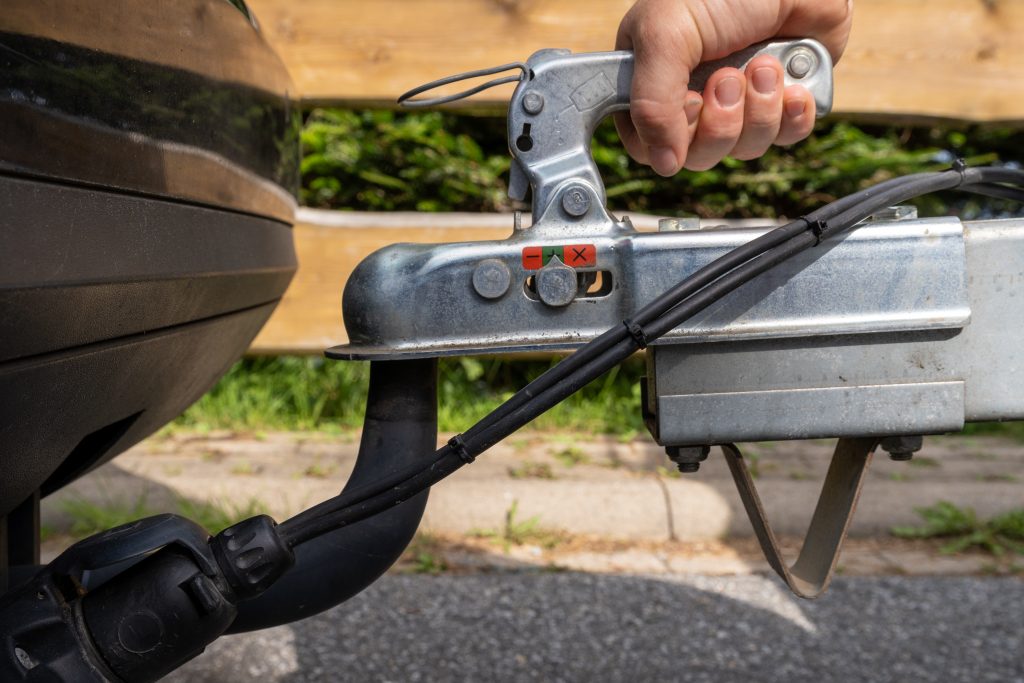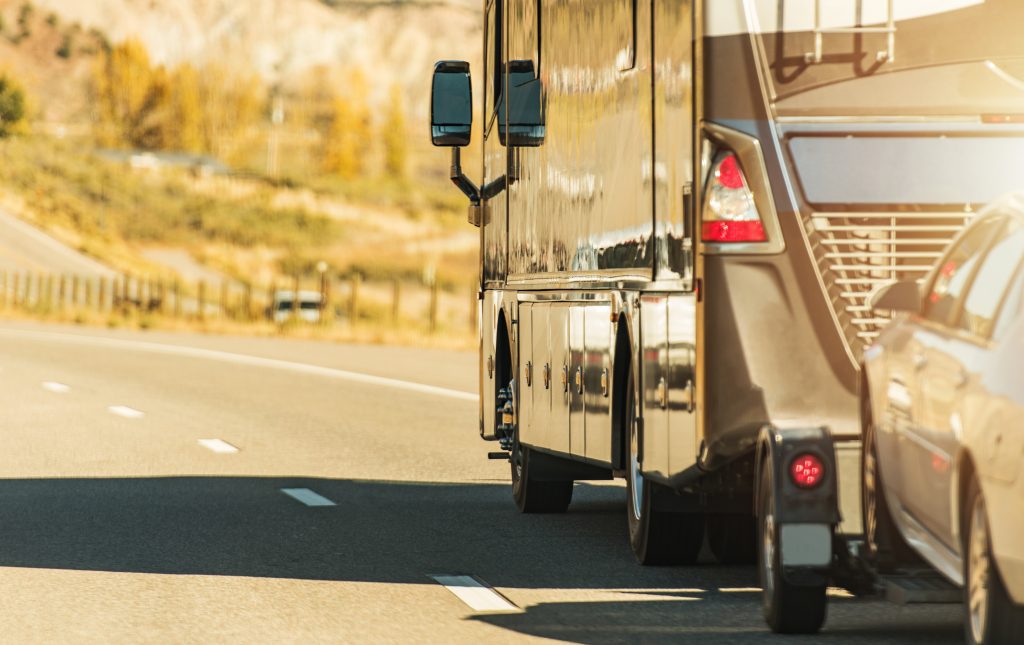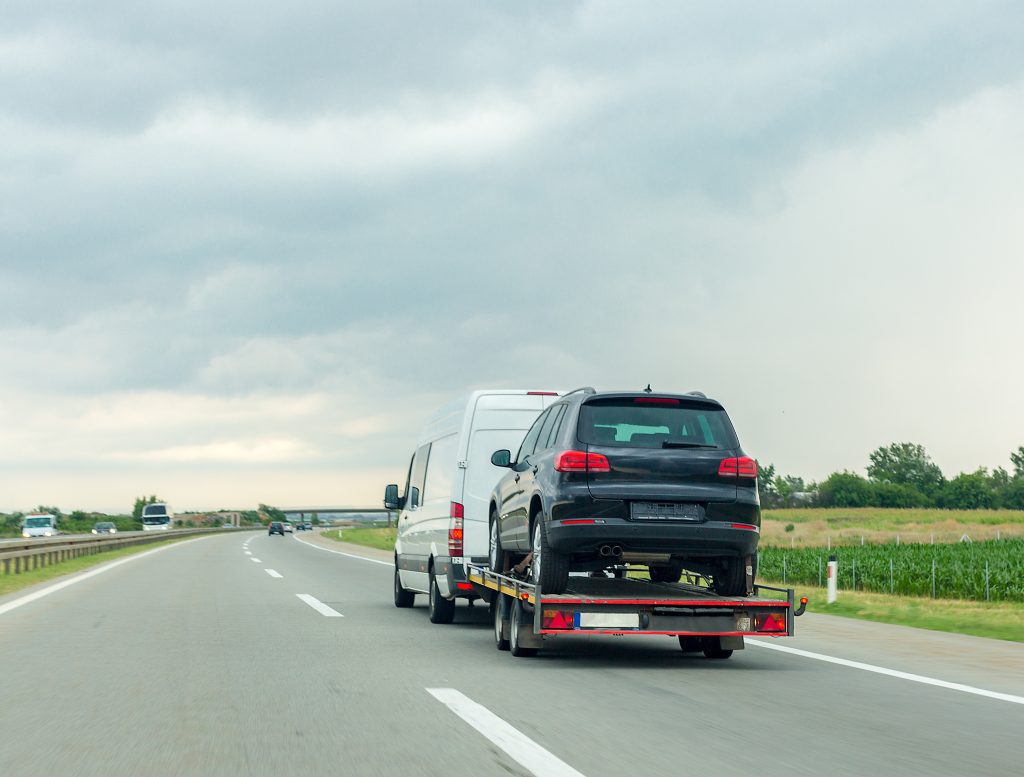How to Tow a Car Behind Your RV: A Comprehensive Guide
There’s no doubt that the joy of the open road is a primary draw for RV enthusiasts. However, for many, the convenience of having a separate vehicle for local transportation once the RV is parked adds a level of practicality.
Join RVnGO on this in-depth guide to explore the three most effective methods to tow a car behind your RV, focusing on the crucial steps, safety tips, and finer details you need to understand.
1. Flat Towing: An Ideal Solution for Light Cars

Flat towing, also referred to as “four-down towing,” is frequently utilized by RV adventurers, particularly suitable for lightweight or tow-ready vehicles. Here, we delve into the specifics of flat towing.
Flat Towing Essentials
Flat towing entails pulling a vehicle with all four of its wheels in contact with the ground. The simplicity of its concept belies the necessity of some crucial equipment: a tow bar, base plate kit, safety cables, supplemental braking system, and possibly a high/low adapter if the heights of the RV and car don’t match.
In essence, the tow bar connects the RV to the car, anchored securely by the base plate kit installed on the front of the car. Safety cables provide an additional layer of security, preventing any potential detachment. The supplemental braking system, mandatory in many states, ensures the towed car can independently initiate braking. Lastly, a high/low adapter is crucial to maintaining an even plane between the vehicles if there’s a significant height difference.
Advantages and Disadvantages of Flat Towing
Pros
- Flat towing is generally more straightforward to set up and disconnect than other methods.
- As no tow dolly or trailer is necessary, storage concerns are significantly reduced.
- The ability to back up without detaching the car offers convenience and flexibility.
Cons
- The towed car’s odometer will accumulate additional mileage.
- Not every vehicle model is suitable for flat towing.
- Some cars may require modification to their drivetrain to facilitate flat towing, which can increase costs and possibly impact warranties.
Tow Dolly: A Suitable Solution for Front-Wheel Drive Cars

If your vehicle isn’t suitable for flat towing, a tow dolly can be an excellent alternative. This device is a small, two-wheel trailer designed to cradle the front wheels of your car while the rear wheels roll freely on the road.
The Procedure for Utilizing a Tow Dolly
Operating a tow dolly involves first connecting it to the RV’s hitch receiver. Once this connection is secure, you drive the front wheels of your car onto the dolly. The car’s wheels are then secured with the provided straps or chains, allowing the rear wheels of the car to roll directly on the road surface.
Benefits and Drawbacks of a Tow Dolly
Pros
- Using a tow dolly reduces wear and tear on the towed vehicle, as the front wheels (and transmission) aren’t engaged during the tow.
- Most front-wheel drive vehicles are suitable for this type of towing, offering a broad compatibility range.
Cons
- A significant limitation is that you can’t back up with the tow dolly attached, which can create challenges in tight spots or when adjusting your parking setup.
- The tow dolly itself requires additional storage space when not in use, which might be a problem if you have limited room at home or in your RV.
Trailer Towing: A Secure Solution for Heavier Vehicles

Trailer towing, or “four-up towing,” is a method that entails loading your car onto a trailer. This approach is typically used for heavier vehicles that cannot be flat towed or placed on a tow dolly.
Basics of Trailer Towing
To perform trailer towing, you first need to connect a car trailer to your RV. Once the hitch connection is secure, the car is driven onto the trailer and then secured in place with chains or straps, ensuring it stays stationary during travel.
Pros and Cons of Trailer Towing
Pros
- Trailer towing ensures no wear and tear on the towed vehicle as none of its wheels are in contact with the road.
- The ability to back up with the trailer attached provides additional flexibility.
- Suitable for all types of vehicles, regardless of weight, size, drivetrain, or wheel-drive orientation.
Cons
- A trailer requires significant storage space, which can be a constraint in some campgrounds or storage facilities.
- The additional weight of the trailer will have an impact on the RV’s fuel efficiency.
Making the Right Choice: Selecting the Appropriate Towing Equipment
The right towing equipment is integral to ensuring that your towing operation is safe, secure, and efficient. The equipment you choose should align with the specifications of your RV and vehicle, including their respective weights, models, drivetrains, and more.
Tow Bars: Your Main Connection
A tow bar is the device that physically connects your car to the RV during flat towing. You can choose between an A-frame tow bar, which is often sufficient for lighter cars, and a self-aligning tow bar, which is better suited to heavier vehicles and provides greater ease during the connection process.
Base Plates: Securing Your Vehicle
Base plates are critical as they secure the car to the tow bar. These are typically specific to your vehicle, necessitating the correct match for effective and safe towing.
Safety Cables: An Essential Backup
Safety cables offer an additional level of security during flat towing by preventing the towed vehicle from potentially breaking away if the hitch connection fails.
Supplemental Braking Systems: Ensuring Safe Stops
A supplemental braking system is not only essential for safety, but it’s also required by law in many states. This system ensures the towed vehicle has the capacity to initiate braking independently, reducing the overall braking distance.
High/Low Adapters: Adjusting Heights
If there is a notable height difference between the hitch on your RV and the base plate on your towed vehicle, a high/low adapter can make necessary adjustments to ensure a level connection.
Essential Considerations When Towing a Car
While selecting the most appropriate method and securing the necessary equipment, there are several factors to take into account to ensure a safe and effective towing process.
Compatibility of Your Car
Confirming your car’s compatibility with the chosen towing method is crucial. The owner’s manual or vehicle manufacturer’s customer service can provide this information.
Legal Implications
Stay aware of the specific towing laws that apply in your state or any area you plan to travel through. Laws can vary considerably, including those regarding the necessity of supplemental braking systems, lighting requirements, maximum towing speeds, and more. Understanding and adhering to these laws can save you from potential penalties and enhance safety.
Safety Precautions
Safety should always be your paramount concern when towing a vehicle. Regularly inspect the connections between your RV and towed vehicle, maintain a safe following distance while driving, and strictly adhere to recommended towing speeds. Additionally, ensure that your towed vehicle’s braking and lighting systems are functioning properly to maintain visibility and control.
Wrapping Up: The Key to Successful Towing
Towing a car behind your RV necessitates careful planning, the right equipment, and strict adherence to safety measures. Whether you opt for flat towing, tow dolly, or trailer towing, each method has its specifics that require understanding and respect. With careful preparation and the right knowledge, you can make your towing experience smooth, safe, and even enjoyable.
In the final analysis, remember that every journey is more than just a trip—it’s an opportunity for unforgettable adventures. The ability to tow a car behind your RV opens up a new world of possibilities, allowing you to explore the local area without moving your entire camp. As you travel smart and safe, take the time to fully enjoy your time on the open road. It’s more than a journey; it’s a lifestyle.